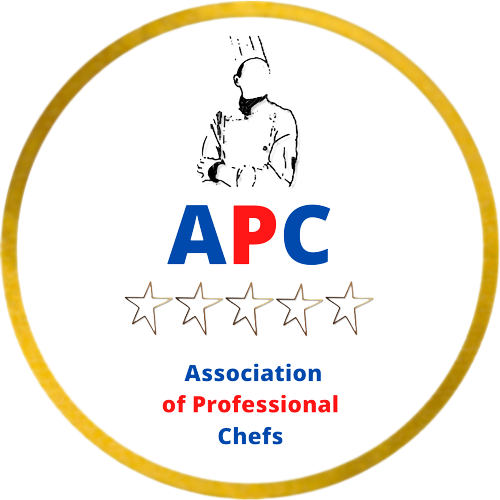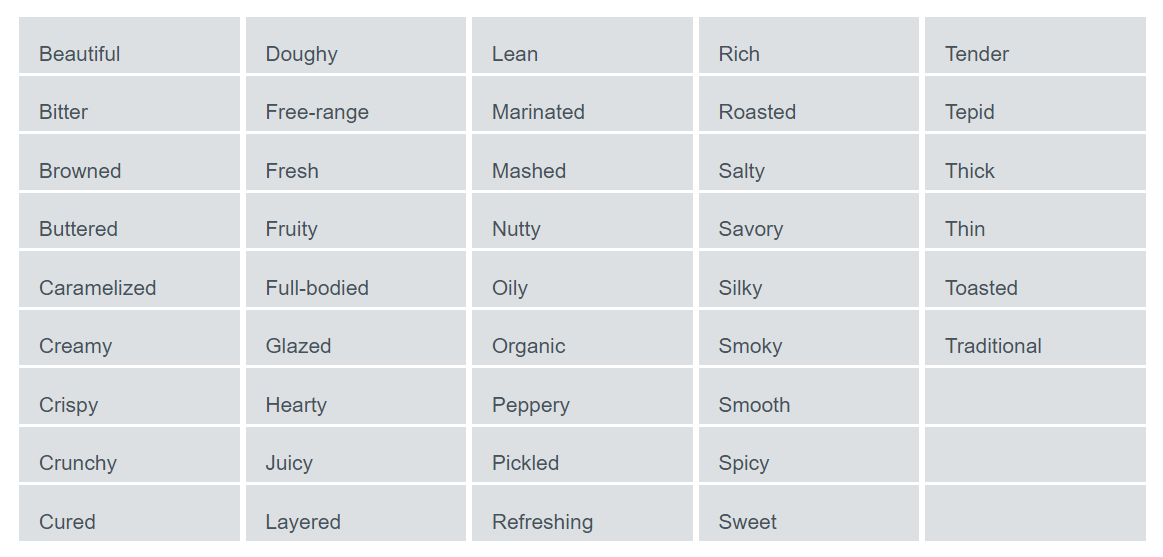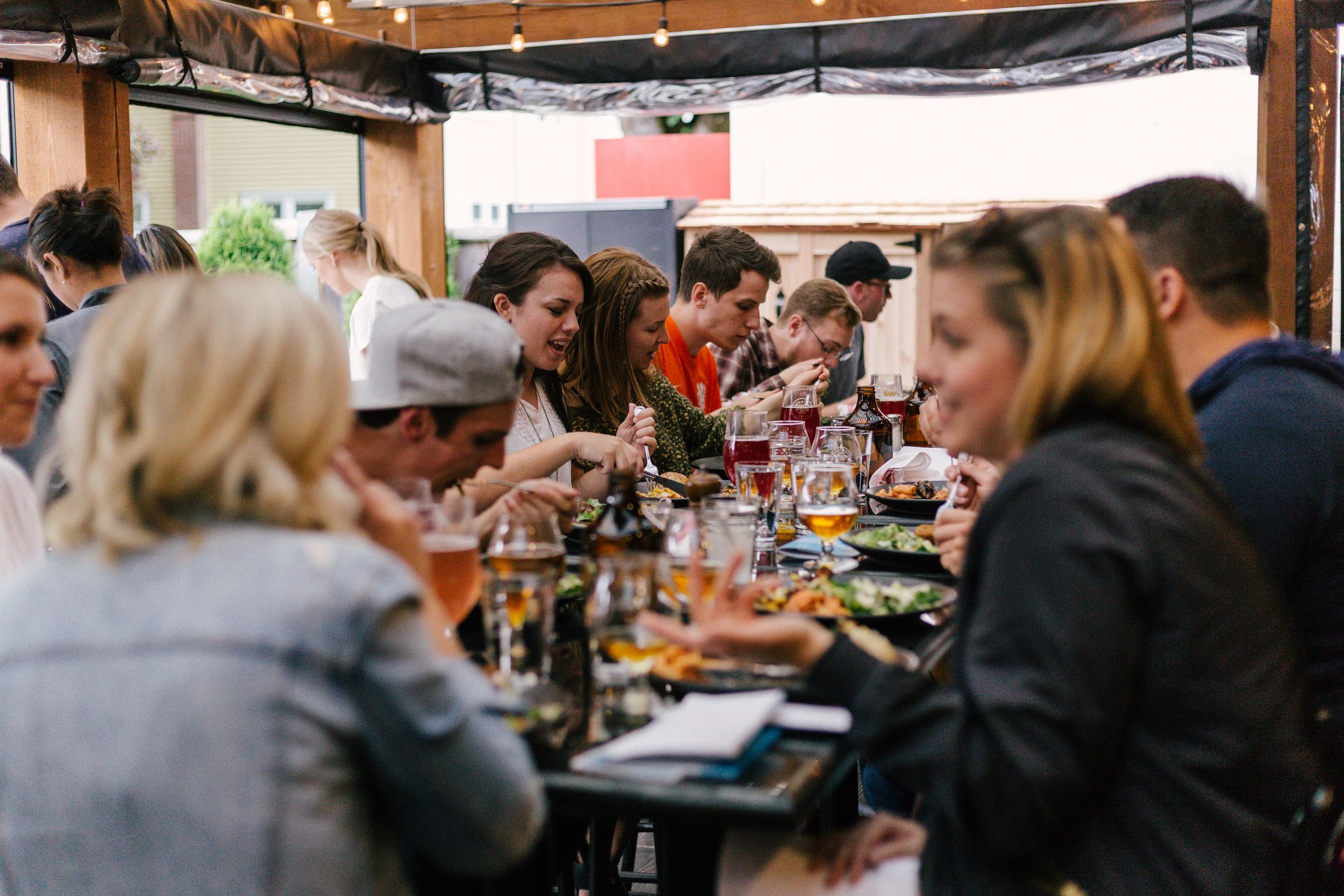English For Restaurant Service
The topics covered in this section are:
Asking and Answering Questions
Recommending and Comparing
In a restaurant, it is very important that customer orders are understood completely. This is especially true when dealing with customers who do not speak your native language. Restaurant staff in hotels and tourist areas often interact with English speaking customers. This section will explain the essential English grammar needed to help customers order in a restaurant.
Asking and Answering Questions
As a waiter or waitress, it is very important to be able to ask and answer questions effectively. Customers will often have questions about the menu in a restaurant. Also, waiting staff will often need to ask customers questions about how they would like their food. To ask and answer questions correctly, restaurant staff must understand the definite article and the indefinite article.
Articles are the small words that come before nouns or adjectives in English sentences. It is important to understand the definite and indefinite articles as they are used in almost every sentence. Restaurant staff will often use definite and indefinite articles when interacting with customers.
Examples:
Would you like a drink?
Our most popular dish is the beef.
There are two different types of articles:
Definite article → the
Indefinite article → a or an
Definite and Indefinite Articles
The Definite Article - the
The definite article is used to refer to one, specific person or object.
Example: I recommend the monkfish dish.
The sentence above makes sense as there is only one monkfish item on the menu.
Example: The maître d' will seat you soon.
This sentence refers to a specific person as there is only one maître d' in each restaurant.
Note: Maître d' is a French word used in English. French words and phrases used in restaurants will be explained in the next unit.
It is important to note that unlike the indefinite article, the definite article is the same for both singular and plural nouns.
Examples:
Singular: Did you enjoy the dessert?
Plural: Did you enjoy the desserts?
The Indefinite Article - a or an
When you are referring to objects generally, you use the indefinite article. The indefinite article is used to refer to things that are one of many.
Example: Would you like a bottle of wine?
The indefinite article a is used in this sentence because there are many bottles of wine in a restaurant.
There are two indefinite articles an and a.
an is used before a noun beginning with a vowel. Remember: The vowels are a,e, i,o and u.
a is used before a noun beginning with a consonant. A consonant is any letter that is not a vowel.
Examples:
Would you like an appetizer?
Would you like a window seat?
However, there are some exceptions to this rule.
Exceptions for u
'U' is a vowel and as such it is most often preceded by the indefinite article. However, this is not always the case. When the u at the beginning of a noun is pronounced uh, the appropriate article is an.
Example:The dessert special is an upside-down cake.
When the u at the beginning of a noun is pronounced you, the appropriate article is a.
Example:The sauce has a unique flavour.
Exceptions for h
H is a consonant and is usually preceded by a.
Example:The fish course is a haddock dish.
However, if a noun begins with a silent h, an is used.
Example:The final course will be served in an hour.
Plural Nouns - Numbers
The indefinite article cannot be used for plural nouns. Plural nouns are nouns used to signify that there is more than one of an object.
Example: portion → portions
Plural nouns are always accompanied by a number in a sentence.
Example: Can I have three portions of rice, please?
Remember: The definite article the is used for plural nouns when you are speaking specifically.
Mass Nouns - some
The indefinite article cannot be used for mass nouns. Mass nouns (also known as uncountable nouns) refer to things that cannot be divided into separate objects. The word 'some' is used in place of the indirect article for mass nouns.
Example: Would you like some coffee, madam?
Coffee is a liquid and cannot be assigned a numeric value. Therefore, it is a mass noun. It is important to note that 'some' is not the indefinite article. Rather, it is a determiner.
Sample Sentences With Mass Nouns
There is some bread on the table.
Would you like some wine?
Would you like some sauce on the side?
Would you care for some cheese?
Could I have some salt, please?
Below is a list of the most commonly used mass nouns for food.
Food Spaghetti
Flour Butter
Meat Oil
Rice Honey
Cake Soup
Bread Fruit
Ice-cream Salt
Cheese Sauce
Toast Tea
Pasta Coffee
Mass Noun + Vessel or Unit
It is important to note that mass nouns also appear in sentences that describe the serving vessel or unit used to serve the food or drink. In these sentences, the noun used for the vessel dictates the article used.
A vessel is a serving dish used to serve liquid food or drink.
Examples:
A cup of coffee.
A bowl of soup.
A unit is a standard measurement used to separate food into different pieces.
Examples:
A slice of bread.
A scoop of ice cream.
Singular Nouns
Singular noun sentences containing vessels or units follow the same rule as indirect article sentences.
Examples:
Without a vessel: Would you like some coffee?
With a vessel/unit: Would you like a cup of coffee?
Plural Nouns
Plural noun sentences containing vessels or units always include a number.
Examples:
Without a vessel: We would like some coffee.
With a vessel/unit: We would like three cups of coffee.
Recommending and Comparing
Some customers will know exactly what they would like to order as soon as they see the menu. Others will seek advice from the waiter/waitress on what they should order.
For this reason, it is important that waiters can provide guidance to customers. To recommend and compare dishes, waiting staff must use adjectives and comparative adjectives.
Below is a list of adjectives commonly used for foods.
Comparing
It is also important to be able to compare different dishes and drinks to help customers decide what they would like to eat. To do this you would use comparative adjectives. Comparative adjectives will help customers to understand the differences between foods.
Note: The rules of comparative adjectives are based upon the spelling of adjectives. Therefore, waiting staff should know how to correctly spell every adjective they use.
Recommending Dishes - Adjectives
To recommend dishes and drinks you will use adjectives. Adjectives are describing words. Their main function is to add detail to nouns (naming words).
Examples:
The chicken has a crispy skin.
The pork comes with a sweet apple sauce.
The potatoes have a silky texture.
Recommending Dishes: Comparative Adjectives
Formation: Generally, comparative adjectives are formed based upon whether they are a one- or two-syllable adjective.
Example:
The panna cotta is sweeter than the chocolate tart.
However, there are some exceptions to these rules. The way in which every kind of comparative adjective is formed is detailed in the following pages.
One-Syllable Adjectives
General Rule: The comparative form of one-syllable adjectives is formed by adding -er.
Example: lean → leaner
Duck meat is leaner than pork.
Exceptions for One-Syllable Adjectives
There are certain types of one-syllable adjectives that are exceptions to the general rule. These are as follows:
One-syllable adjective ending in -e
Rule: add -r
Example: large → larger
The sirloin steak is larger than the fillet.
One-syllable adjective ending with a single consonant preceded by a single vowel.
Rule: repeat last letter + er
Example: flat → flatter
Focaccia bread is flatter than ciabatta.
Two-Syllable Adjectives
General Rule: the comparative form of two-syllable adjectives is created by adding the word 'more' before the word.
Example: intense → more intense
Nattō has a more intense flavor than Rajma.
Exceptions for Two-Syllable Adjectives
There are certain types of two-syllable adjectives that are exceptions to the general rule. These are as follows:
Two syllable adjectives ending in -y
Rule: replace -y with -i and add -er
Example: spicy → spicier
The fish curry is spicier than the jerk chicken.
Two-syllable adjectives ending in -ow
Rule: add -er
Example: mellow → mellower
Apples have a mellower flavor than lemons.
Two-syllable adjectives ending in -le
Rule: add -r
Example: subtle → subtler
Merlot has a subtler flavor than pinot noir.
Two-syllable adjectives that follow two rules
The following adjectives can be formulated into the comparative form using the general rule or an exceptional rule:
Clever → cleverer/ more clever
Gentle → gentler/ more gentle
Friendly → friendlier/more friendly
Quiet → quieter/more quiet
Simple → simpler/ more simple
Adjectives With Three or More Syllables
Adjectives with three or more syllables are formed into the comparative form by adding the word 'more' before the adjective.
Example: traditional → more traditional
The partridge dish is more traditional than the chicken.
There are no exceptions for adjectives with three or more syllables.
The Passive Voice
An important English language skill for describing dishes is the passive voice. In each English sentence, the parts of a sentence can be formatted using one of two voices; the active voice or the passive voice.
Generally, the active voice is preferred as it is easier to understand. However, there are some contexts in which the passive voice is preferred. The passive voice is more appropriate for describing dishes in a restaurant as it focuses the diners' attention on the food.
Parts of a Sentence
The basic parts of a sentence are the subject and the verb. Each sentence in English must contain these parts to be considered grammatically correct. Most sentences also contain another part known as an object.
The ways in which these parts are arranged defines whether a sentence is in the active or passive voice.
Active Voice: In the active voice, the subject of the sentence performs the actions expressed by the verb.
Example: The chef cooked the dinner.
The chef is the subject,
Cook is the verb,
The dinner is the object.
Passive Voice: In the passive voice, the subject of the sentence receives the action expressed by the verb.
Example: The dinner was cooked by the chef. As in the previous example;
The chef is the subject,
Cook is the verb,
Dinner is the object.
However, the focus of this sentence is the dinner, not the chef.
Passive Sentences Without an Object
Often when using the passive voice there is no need to include an object in the sentence.
Example: The dinner was cooked. In this case:
Dinner is the subject.
Cooked is the verb.
The chef is not mentioned in this sentence. Therefore the dinner becomes the subject of the sentence.
Sentences without an object are common in the passive voice. These sentences do not mention the agent or ‘doer' of the action. Such sentences are used when the agent is:1.Unknown,
2.Considered unimportant,
3.Already known by the listener.
The Past Participle
The verb form used in the passive voice is the past participle. The past participle is formed by adding an ending to the base form of a verb.
Below is a list of the most common irregular verbs in the past participle form.
The past participle of regular verbs is formed by adding one of two endings:
ed: deliver → delivered
d: waste → wasted
The past participles of irregular verbs have various endings the most common of which are
d: say → said
n: spoke → spoken
t: sleep → slept
Formulation
There are two methods of formulating a passive sentence:
A sentence that includes an object.
A sentence that does not include an object.
Remember: Passive sentences that do not contain an agent have no object.
A Sentence That Includes an Object
The process for formulating a passive sentence that includes an object is:
Place the object at the beginning of the sentence.
Conjugate the verb to be in the appropriate tense:
was for the past tense.
is for the present tense
will be for the future tense.
Place the main verb in the past participle form.
Place the subject at the end of the sentence.
Example: The soufflé was prepared by the pastry chef.
The soufflé is the object of the sentence, therefore, it is at the beginning.
The appropriate tense is the past tense therefore to be is conjugated as was.
The past participle of prepare is prepared.
The subject of the sentence is the pastry chef.
A Sentence That Does Not Include an Object
The process for formulating a passive sentence that does not include an object is:
Place the subject at the beginning of the sentence.
Conjugate the verb to be in the appropriate tense:
was for the past tense.
is for the present tense.
will be for the future tense.
Place the main verb in the past participle form.
Example: The soufflé was prepared.
The soufflé is the subject of the sentence.
The appropriate tense is the past tense; therefore to be is conjugated as was.
The past participle of prepare is prepared.
Remember: If you remove the agent from a passive sentence, what was the object becomes the subject.
The soufflé was prepared by the pastry chef → The soufflé was prepared.
The pastry chef is the agent of action in the first sentence and hence the subject.
There is no agent in the second sentence; therefore, the soufflé becomes the subject.
Most of the time that you are describing dishes to customers your sentences will not have an object. This is because it is more appropriate to talk about how the dishes are prepared rather than who prepared them. The only time you should mention the chef and kitchen staff is when customers ask about them.
Examples:
Without an object:
Customer: How is the lamb cooked?
Waiter/waitress: The lamb is slow-cooked with onions and thyme.
With an object:
Customer: How does the chef cook the lamb?Waiter/waitress: The lamb is slow-cooked with onions and thyme by the chef.
Examples of the passive voice used to explain dishes:
The beef is slow cooked in red wine and beef stock.
The chicken is marinated in herbs and spices.
Our bread is baked fresh every day.
Past-Participle as an Adjective
As stated earlier, the past participle is the verb form used in the passive voice. However, the past participle can also be used as an adjective. Past-participle adjectives are most often used to describe how a person feels.
Example: The sentence “Cooking interests John” can be re-written as “John is interested in cooking.”
In a restaurant, past-participle adjectives are used to describe how a dish is prepared or cooked.
Examples:
The vegetables are steamed.
The chicken is stir-fried.
The salmon is poached.
The duck comes with a side of roasted carrots
Past-Participle Adjectives on Menus
Past-participle adjectives are also used on menus. Once again, their purpose here is to describe how a dish is prepared or cooked.
Examples:
Roasted Vegetables,
Poached Salmon,
Grilled Sirloin Steak.
Exceptions - Past Participle or Infinitive
A past-participle or an infinitive adjective can be used for certain foods on a menu. Waiting staff can use either form of these verbs when describing a dish.
Example:
Past Participle: The beef comes with a side of sautéed potatoes.
Infinitive: The beef comes with a side of sauté potatoes.
The most common adjectives for listing or describing food that follow this rule are:
Both versions of sauté, barbeque and mash are commonly used.
The infinitive of roast is almost always used, especially when referring to meat dishes. However, the past-participle is sometimes used to describe side dishes such as vegetables, etc.
French Words and Phrases
On many English restaurant menus, there will be French words and phrases. This is especially true in upmarket restaurants. The reason for this is that gourmet restaurants originated in France.
Waiting staff must be familiar with these terms to effectively describe dishes. This section lists and defines the most common French words and phrases found in English language menus.
As well as knowing and understanding the rules of grammar, there is some important English vocabulary that waiting staff should know.
This unit will introduce key expressions for waiters and waitresses and explain when to use them. This unit is divided into three sections:
Greeting and Seating Customers,
During Service,
Accepting Payment and Customer Departure.
Greeting and Seating Customers
As a restaurant host or hostess, it is very important to greet customers politely. This section will teach you the essential English phrases needed to correctly greet customers and take them to their seat.
When customers arrive at the restaurant you should greet them immediately:
Good evening.
Next, you should ask the customers how many people will be sitting at their table:
How many are in your party?
If you see a couple or a group of people arriving at the same time you may assume that they are in the same group:
Table for two/three/four etc.?
The restaurant you work in may have a reservation policy. If this is the case, ask each set of customers that arrive if they have a reservation:
Do you have a reservation?
If the customers reply yes, ask about the details of their reservation:
What name is the booking under?
Once you have taken the customers' details offer to take their coats:
May I take your coats?
If the restaurant is very busy, customers may have to wait to be seated. In this case, apologize and tell them how long they'll be waiting:
I apologize, it's going to be a ten/fifteen/twenty-minute wait. Is that ok?
Once the wait is over you should find the customer(s), apologize for the wait and inform them that their table is ready:
I apologize for the wait, your table is ready.
You should escort the customers to their table w:ith the following phrase
Right this way, please.
Next, you should introduce the customers to their waiter:
Peter will be your waiter this afternoon/ this evening.
Finally, excuse yourself and wish the customers an enjoyable meal:
Have a wonderful lunch/evening. I hope you enjoy your meal.
Taking Orders and During the Meal
Once the customers arrive at their table you should welcome them and introduce yourself.
Welcome to La Trattoria, my name is Peter.
Next, tell the customer about the specials of the day.
Our special today is roast pork belly, with creamed mash potato and steamed vegetables.
It is then expected that you offer to get the customers a drink as they take a look at the menu.
Would you like something to drink?
When you arrive with the drink order you should ask the customers if they have decided what they would like:
May I take your order?
If it appears that the customers have not made up their minds, ask them if they need more time:
Would you like more time to decide?
Once the customers are ready you can begin taking orders. You ask the first customer what they would like with the phrase:
What can I get for you?
Following this you should ask each customer:
...and for you sir/madam?
When each customer has finished ordering, confirm that you have heard and understood the order by saying:
Certainly sir/madam
If a customer orders something that's no longer available, apologize and recommend something else:
I'm very sorry, we're sold out of pork. Would you like chicken instead?
As you bring each course to the table ask the customers if they need anything:
Can I get you anything else?
Occasionally, you may check to see if the customers are enjoying their meal. To do this simply ask:
How is everything?
Accepting Payment and Customer Departure
Once customers have finished their meal, ask them if they would like to see the bill:
Would you like the bill?
Once the bill has been paid, thank the diners for their custom:
Thank you very much.
Finally, say goodbye to the customers:
Goodbye, I hope to see you again.
Below is a summary of the key learning in the module.
To ask and answer questions correctly, restaurant staff must utilize the definite and indefinite article correctly.
The word the is used to represent the definite article.
The words a and an are used to represent the indefinite article.
a is used before a noun beginning with a consonant.
an is used before a noun beginning with a vowel.
There are some exceptions to the indefinite article rule.
To recommend and compare dishes, waiting staff must use adjectives and comparative adjectives.
Generally, the comparative form of one-syllable adjectives is formed by adding -er.
Generally, the comparative form of two-syllable adjectives is created by adding the word more before the word.
Three-syllable comparative adjectives are always formed by adding the word more before the word.
The passive voice is appropriate for describing restaurant dishes as it focuses the diners' attention on the food.
Lesson Summary
The process for formulating a passive sentence that includes an object is:
• Place the object at the beginning of the sentence.
• Conjugate the verb to be in the appropriate tense
.• Place the main verb in the past participle form.
• Place the subject at the end of the sentence.
The process for formulating a passive sentence that does not include an object is:
• Place the subject at the beginning of the sentence.
• Conjugate the verb to be in the appropriate tense.
• Place the main verb in the past participle form.
Restaurant staff should use past-participle adjectives to describe how a dish is prepared or cooked.
Past-participle adjectives are used on menus to describe how a dish is prepared or cooked.
A past-participle or an infinitive adjective can be used for certain foods on a menu.
On many English restaurant menus, there will be French words and phrases.
Waiting staff must be familiar with French terms to effectively describe certain dishes.
As well as knowing and understanding the rules of English grammar, restaurant staff should be aware of the key English expressions used for restaurant service.









